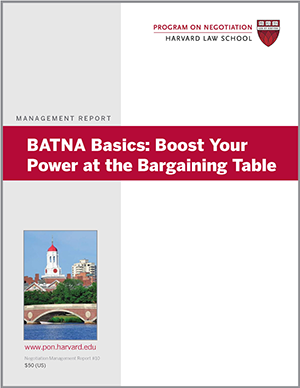
Business negotiators know that persistence and tenacity can make all the difference between impasse and a game-changing breakthrough. Take the saga behind Microsoft’s 2013 announcement of its pending $7.2 billion acquisition of Finnish mobile phone company Nokia’s handset and services business. The two parties engaged in many months of fruitless talks before either side believed that an agreement was likely—yet a late-stage brainstorming session brought them together. We analyze the negotiations with an eye toward identifying why things suddenly went right after so much had gone wrong.
Nokia builds its BATNA
Microsoft and Nokia had been partners since 2011, when the Finnish firm began installing Microsoft’s Windows Phone operating system (OS) on its smartphones. But the arrangement had been disappointing. Nokia was lagging far behind smartphone manufacturers Samsung and Apple in terms of innovation and market share, and the Windows Phone OS, used primarily on Nokia handsets, was failing to meet expectations as well.
In January 2013, Microsoft CEO Steven Ballmer made a quick phone call to Risto Siilasmaa, the chairman of Nokia’s board of directors, to raise the possibility of Microsoft buying divisions of Nokia. The following month, the two men sat down at a wireless-industry conference in Barcelona, Spain, to discuss the idea further. The two leaders agreed that inefficiencies existed in their current agreement, including duplicate engineering, marketing, and advertising efforts. Then they brainstormed solutions ranging from minor tweaks to their current deal to more extensive collaborations and business mergers, reports Ina Fried on the technology news website AllThingsD.com.
Nokia narrowed in on two possible options. First, it could sell its underperforming handset business to Microsoft or another company and focus on its telecommunications equipment, mapping, and patent businesses. Second, it could let its deal with Microsoft lapse at the end of 2014 and try to revive its handset business by adapting its smartphones to Google’s Android system. In fact, Nokia informed Microsoft that one of its teams already had Android up and running on Nokia’s Lumia handsets. By cultivating this strong BATNA, or best alternative to a negotiated agreement, Nokia gained the power to walk away from a subpar offer from Microsoft.
Early stumbles between business negotiators
In fact, Nokia executives did just that—turned down a disappointing proposal—immediately after listening to Microsoft’s first formal pitch for an acquisition at an April 2013 meeting in New York. Siilasmaa and his team informed Ballmer and his team that they were too far apart on price and other key issues, such as which company would own Here, Nokia’s mapping service. The Nokia executives believed strongly that they needed to hold on to Here and their ability to sell the software to other companies. Meanwhile, Microsoft felt it couldn’t keep pace with competitors without controlling the mapping technology it was using in its phones, tablets, and PCs and on the web, according to AllThingsD.com.
The next month, a meeting between the two teams in the London office of Microsoft’s law firm also flopped, and not just because Ballmer tripped over a glass coffee table and cut his forehead in the middle of it. (The injury turned out to be minor.) A follow-up meeting at a Nokia-owned mansion in Finland the following month was aborted after four hours because of lack of progress, according to the New York Times.
A deal takes shape
A breakthrough came when Nokia informed Microsoft that it would proceed with formal talks only if Microsoft agreed to abide by certain preconditions, most notably a commitment to set up a financing source for Nokia and the caveat that Here was off the table.
Microsoft agreed. The parties met in early July 2013 in New York, where in the course of discussion they happened upon a solution to the question of who would control the mapping service. Why not share the code, with Nokia retaining intellectual-property rights to Here? Nokia realized that it could grant Microsoft a license to access and customize Here’s source code and own any improvements it made. Nokia would retain ownership of Here and the power to license the service to other companies.
At the end of a weekend of talks, Ballmer and Siilasmaa shook hands on the rough outlines of an agreement, which was filled out over the next two months. As part of the deal, 32,000 Nokia employees, including CEO Stephen Elop, would be hired by Microsoft. A former Microsoft executive, Elop was considered a likely successor to Ballmer, who announced plans to retire within a year.
Lessons learned
The Microsoft-Nokia deal offers several useful takeaways for business negotiators:
■ Don’t jump the gun on price. In its initial presentation, Microsoft lost Nokia’s interest by making a price offer that the Finnish firm considered far too low. Microsoft may have erred by raising the issue of price before it understood key aspects of Nokia’s business and its interests in a potential sale. For this reason and others, it often makes sense to hold off on making concrete price offers until later in a negotiation, after you have engaged in thorough fact-finding.
■ Be open about your BATNA. Nokia not only cultivated a strong alternative to a deal with Microsoft—the capability to jump ship from Windows Phone to Android technology—but also shared this confidential development with Microsoft. A strong BATNA brings with it negotiating power, especially when the other side knows that you could easily walk away.
■ Keep talking. The parties could have gone their separate ways after their first meeting. Instead, each assigned teams to explore issues and tradeoffs they may have overlooked or undervalued. The two sides continued to meet despite a series of deadlocked talks—and eventually reached a point where they could brainstorm creative deal terms.
Setting negotiating conditions: A risky move
Interestingly, it was only after Nokia laid out conditions to future discussions with Microsoft—financing commitments and taking Nokia’s mapping service off the table—that the negotiating teams were able to reach agreement.
Insisting that the other party agree to certain terms as a precondition to negotiation is a common but risky tactic. For example, in the Minnesota Orchestra’s labor dispute, for example, the players said for many months that they would negotiate with management only after the lockout ended. But management was loath to accept this condition, aware that the players would have little motivation to accept significant salary cuts if they were performing and being paid.
As the failure of this condition illustrates, setting conditions to negotiation is a potentially self-defeating strategy. Remember that your counterpart will weigh the costs and benefits of accepting your conditions against his alternatives away from the table. If you have a strong BATNA, as Nokia appears to have had, then it may make sense to take this risk. But note that even in this case, Microsoft was able to make inroads on the mapping service issue that Nokia had claimed was nonnegotiable. Microsoft may have saved the deal by refusing to assume that Nokia’s conditions to negotiation were nonnegotiable.
In general, the wisest course for business negotiators may be to agree to negotiate rather than stipulating potentially deal-breaking conditions. Then, at the table, seek tradeoffs that will help you gain leverage on the issues you value most, while demonstrating flexibility on your counterpart’s pressing concerns.
What is some advice you’d offer to other business negotiators?





